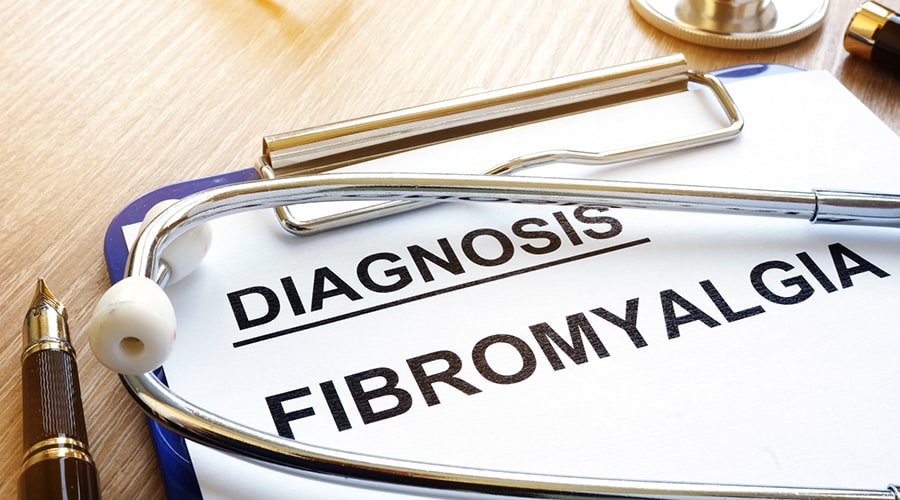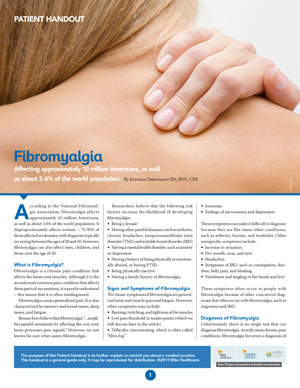
Affecting approximately 10 million Americans, as well as about 3-6% of the world population
According to the National Fibromyalgia Association, fibromyalgia affects approximately 10 million Americans, as well as about 3-6% of the world population. It disproportionately affects women – 75-90% of those affected are females, with diagnosis typically occurring between the ages of 20 and 50. However, fibromyalgia can also affect men, children, and those over the age of 50.
What is Fibromyalgia and how is it diagnosed and treated?
Fibromyalgia is a chronic pain condition that affects the bones and muscles. Although it is the second most common pain condition that affects these parts of our anatomy, it is poorly understood – this means that it is often misdiagnosed.
Fibromyalgia causes generalized pain.
It is also characterized by memory and mood issues, sleep issues, and fatigue. Researchers believe that fibromyalgia “…amplifies painful sensations by affecting the way your brain processes pain signals.” However, no one knows for sure what causes fibromyalgia.
Researchers believe that the following risk factors increase the likelihood of developing fibromyalgia:
- Being a female
- Having other painful diseases, such as arthritis, chronic headaches, temporomandibular joint disorder (TMJ), and irritable bowel disorder (IBD)
- Having a mental health disorder, such as anxiety or depression
- Having a history of being physically or emotionally abused, or having PTSD
- Being physically inactive
- Having a family history of fibromyalgia
Signs and Symptoms of Fibromyalgia
The classic symptoms of fibromyalgia are generalized joint and muscle pain and fatigue. However, other symptoms may include:
- Burning, twitching, and tightness of the muscles
- Low pain threshold or tender points (which we will discuss later in the article)
- Difficulty concentrating, which is often called “fibro fog”
- Insomnia
- Feelings of nervousness and depression
These symptoms can make it difficult to diagnose because they are like many other conditions, such as arthritis, bursitis, and tendinitis. Other nonspecific symptoms include:
- Increase in urination
- Dry mouth, nose, and eyes
- Headaches
- Symptoms of IBD, such as constipation, diarrhea, belly pain, and bloating
- Numbness and tingling of the hands and feet
These symptoms often occur in people with fibromyalgia because of other concurrent diagnoses that often occur with fibromyalgia, such as migraines and IBD.
Diagnosis of Fibromyalgia
Unfortunately, there is no single test that can diagnose fibromyalgia. As with many chronic pain conditions, fibromyalgia becomes a diagnosis of exclusion, meaning that other conditions that are easily diagnosed are ruled out first.
Your physician may order lab work and imaging to determine if there are any underlying muscular or joint issues, as well as lupus, thyroid, or chronic inflammation issues. If these conditions are all ruled out, a diagnosis of fibromyalgia becomes more likely.
A tender point is often used to help diagnose fibromyalgia. A tender point, according to PubMed, is “…areas of muscle that are painful to palpation and are characterized by the presence of taut bands and the generation of a referral pattern of pain. Tender points are areas of tenderness occurring in muscle, muscle-tendon junction, bursa, or fat pad. When tender points occur in a widespread manner, they are usually considered characteristic of fibromyalgia.” They occur in a symmetrical pattern.
In 1990, the American College of Rheumatology created diagnosis guidelines that stated that a diagnosis of fibromyalgia required “…a history of widespread pain in all four quadrants of the body for a minimum duration of three months, and pain in at least 11 of the 18 designated tender points when a specified amount of pressure is applied.” This criterion was difficult because practitioners did not know how much pressure to apply, and pain varied day-to-day.
The American College of Rheumatology updated the diagnosis guidelines in 2010; these points are not used but rather widespread pain is evaluated. This pain should be accompanied by other symptoms, such as problems with sleep, “fibro fog”, and fatigue.
Treatment of Fibromyalgia
Treatment of fibromyalgia is typically multifaceted. This means that a doctor will likely prescribe medications, but they’ll likely also recommend dietary changes as well as exercise – and maybe alternative medicine too!
Unfortunately, there is no cure for fibromyalgia, so attempting to keep symptoms at bay and then treating symptoms is recommended.
Exercise is recommended. Exercising may seem difficult when the entire body is in pain, but regular exercise can improve pain and improve sleep. According to WebMD, exercise increases the body’s production of endorphins, which are thought to be the body’s natural painkillers.
Physical therapy may be ordered if the body becomes very stiff and pain becomes intense. According to WebMD, “…physical therapy helps with ‘new’ muscle memory and neuroendocrine changes in a positive way to help your muscles recover.”
Likely, medications will be prescribed. These drugs all have a multifaceted “approach” to treatment:
- Duloxetine (Cymbalta) is an antidepressant that has been FDA-approved to treat fibromyalgia. In addition to treating fibromyalgia, it also treats depression – a boon for people with fibromyalgia who also have mental health disorders.
- Amitriptyline (Elavil) is another antidepressant that can treat a myriad of fibromyalgia symptoms, such as pain, depression, and insomnia.
- Pregabalin (Lyrica) has also been FDA-approved to treat fibromyalgia. Lyrica also treats pain associated with fibromyalgia.
- Milnacipran (Savella) is another FDA-approved medication in the same drug class as Cymbalta. It acts similar to antidepressants, but it does not actually treat depression. It treats a variety of fibromyalgia symptoms, such as pain, improved physical functioning, and generalized improvement in fibromyalgia symptoms.
Other medications may be prescribed based on symptoms, such as sleeping medications for sleep disturbances, pain medications for pain that is resistant to the aforementioned medications, and muscle relaxants.
Various alternative treatment may be effective in treating symptoms of fibromyalgia:
- Acupuncture may alter the chemistry of the brain, therefore improving symptoms.
- Chiropractic care may improve pain in general.
- Massage may ease muscular tension and promote circulation.
- Meditation may help to reduce anxiety.
- Tai chi and qi gong are two Chinese practices that may help with pain, insomnia, and depression.
Resources
Borg-Stein, J., & Stein, J. (1996, May 22). Trigger points and tender points: one and the same? Does injection treatment help? Retrieved from https://www.ncbi.nlm.nih.gov/pubmed/8860801
Mayo Clinic. (2017, August 11). Fibromyalgia – overview. Retrieved from https://www.mayoclinic.org/diseases-conditions/fibromyalgia/symptoms-causes/syc-20354780
National Fibromyalgia Association. (N.D.) Diagnosis. Retrieved from http://www.fmaware.org/about-fibromyalgia/diagnosis/
National Fibromyalgia Association. (N.D.) Prevalence. Retrieved from http://www.fmaware.org/about-fibromyalgia/prevalence/
WebMD. (2017, August 17). Fibromyalgia treatments. Retrieved from https://www.webmd.com/fibromyalgia/guide/fibromyalgia-treatments#1







